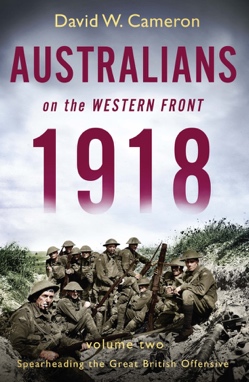In this, the second in a two-volume series, Cameron tells the story of Australian troops on the Western Front from May to November 1918. He covers Monash’s taking command of the Australian Corps, the lead up and conduct of the Battle of Hamel (4 July), the Battle of Amiens (8-12 July), the Battle for Mont St Quentin and Péronne (31 August – 3 September), the battles for the Hindenburg Outpost Line (18 September) and the Hindenburg Line (29 September) culminating with the capture of Beaurevoir and Montbrehain (3-5 October).

Cameron recounts the military successes and challenges of the Australian Corps, during which many troops tragically lost their lives just as the war was finally drawing to a close. Ultimately, however, the breaking of the Hindenburg Line by Australian, Canadian, British and American troops delivered a crucial blow to the German army, who entered into an armistice with the Allies one month later. This book bears witness to the sacrifice and victories of the Australian Corps, which acted as ‘shock troops’ for the British Expeditionary Force despite their ongoing casualties and dwindling reinforcements.
Cameron once again draws on the diaries and letters of the participants to weave together a dynamic narrative around the significant moments that marked the defeat of the German Army, placing their actions within the broader strategic context. Cameron also covers the significant role that units from the American Expeditionary Force played as part of the Australian Corps in this period. His account strikes a good balance between being informative and entertaining.
Cameron completed his PhD in biological anthropology at the Australian National University and is a former Australian Research Council QEII Fellow at the Department of Anatomy and Histology, University of Sydney. He is the author of several books on Australian military history and primate evolutionary biology and has published over 60 papers in internationally peer-reviewed journals.
The book includes: 16 pages of black-and-white images; eight good quality maps to illustrate the movement of units in several battles; the order of battle of the Australian Corps down to infantry battalion level in mid-September 1918; extensive notes; a list of references; and a detailed index. The book’s publication is timely as we reflect on the final year of the Great War and Australia’s part in it.
Contact Marcus Fielding about this article.






